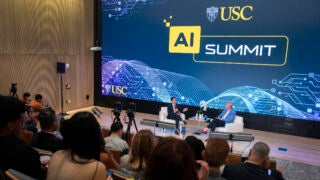What makes an ad go viral on YouTube?
Unlike expensive TV time, YouTube is free and has over 1 billion users. But how do you grab them with an enticing ad? One USC Marshall professor has a few tips.
A few years ago, a video of a puppy’s unlikely friendship with a Clydesdale horse went viral.
Although Budweiser wasn’t mentioned till the last frame, the Super Bowl ad “Puppy Love” showed the power of emotions — and puppies — when it comes to captivating audiences. And although it got a lot of talk for its prime-time placement, its views on YouTube kept rising — racking up millions of hits since its 2014 TV debut. It remains one of the most-liked Super Bowl ads of all time.
“There’s been a transformation in advertising in the last 10 years or so,” USC Marketing Professor Gerard Tellis said. “The YouTube ad is now the ultimate — and making it go viral is the goal.”
Unlike pricey TV placement, YouTube is free and has over 1 billion users.
“The next big question is, what causes virality?” Tellis said.
That’s what Tellis and his team have been studying at the USC Marshall School of Business, publishing their findings in a recent paper. They studied hundreds of viral ads posted on channels, not the paid ads that users are forced to watch. After studying these videos over several years, they found some key factors.
Appeal to emotions
In order for a video to go viral, users need to not only “like” it, they need to share it. And when it comes to engagement, storytelling is No. 1.
The plot should be dramatic and evoke emotions, such as inspiring, suspenseful or surprising and funny, researchers found. In Budweiser’s “Puppy Love,” a Golden Retriever puppy escapes from its pen, running over to an adjacent farm’s stable where it befriends a Clydesdale horse. This happens over and over, the farmer having to return the dog to his neighbor again and again. Eventually, as the puppy is leaving in a car — presumably to be with its new owner — the Clydesdale escapes from the farm to chase after it. It ends with the puppy and the Clydesdale reunited — and the hashtag #BestBuds and Budweiser on the final frame.
The ad hit all the marks, including the importance of “cute stimuli,” Tellis said. Babies are another effective cute factor, as seen in viral ads by Evian, which feature dancing, roller skating or surfing babies. In those, the last frame shows Evian and the slogan “live young.”
Anyone who has shared a meme might think this is a no-brainer. Studies show that humans love looking at human and animal babies, drawn to their big eyes and rounded faces. But USC researchers found only 3% of the ads surveyed featured animals or babies. Nearly 30% featured celebrities, which are also effective but costly to book, Tellis said.
You have to be engaging. People are multitasking. Time is precious.
Gerard Tellis
Advertisers need to see YouTube as a distinct place for branded storytelling, Tellis said. And looking at their data, they have a ways to go. Only 15% of the ads they surveyed used emotion-provoking storytelling. The majority, 55%, were more informative, using argument to get their brand proposition across.
While puppies don’t scream beer and water from the French Alps doesn’t exactly correlate with coordinated toddlers, Tellis said it’s true that the closer the connection the brands can have to the content, the better.
At the end of the day, the commercial should feel connected to the brand’s ethos — but when it comes going viral, the most important thing is that it grabs people, he said.
“The closer the link the better,” he said, “but you have to be engaging. People are multitasking. Time is precious.”
To go viral, don’t go infomercial
When it comes to YouTube, avoid informational ads, Tellis said.
“What we find is information is rarely shared. It’s dry and uninteresting,” he said. “It has figures and facts and arguments.”
These ads can come off similar to TV ads, and users don’t want to feel like they’re endorsing or sponsoring a brand, Tellis said.
There’s an exception to that: when an informational ad is especially newsworthy or is giving exclusive information. A good example: Amazon’s ad for its drone delivery service, which they found to be the most popular after the Budweiser ad.
The Amazon ad showed how the drone delivery service would work — with a “behind the scenes” documentary-style shoot of the items going through the factory to be then loaded onto Amazon PrimeAir drones. They then fly out the factory doors for delivery. When playing the ad for a journalist, Amazon Founder Jeff Bezos said, “I know this looks like science fiction.”
Although the ad wasn’t grabbing us with a strong narrative, it showed us how delivery services might change in the future in a captivating way.
Be careful with brand placement
Heavy-handed branding doesn’t bode well for brands, USC researchers found. The best ads delayed the brand’s name and logo till the end of the commercial. It might be something advertisers aren’t paying attention to because of the surveyed ads, only a third held off on branding until the end.
But YouTube has also a different audience than TV. With TV commercials, advertisers needed to remind watchers as they tuned in. Now, a YouTube user is making a decision to watch an ad and likely knows who is behind it, whether it’s on the description or its a branded channel itself.
“The strategy has changed from just buying with money to cleverly creating the most effective ad,” Tellis said.
Instead of spending so much money on big media buys, Tellis said, advertisers could invest more creative brain power in ads posted to YouTube. While TV ads of the past might be under a minute, YouTube allows more time. Researchers found the sweet spot to be between 1 and 1½ minutes.
“You need that much time to be engaging,” he said.
And all of this can translate to dollars for advertising agencies, Tellis said. His team found that a viral ad translates to about $1.3 million per day in increased stock market value.



